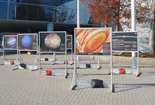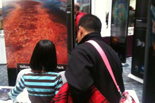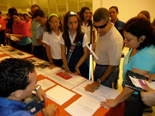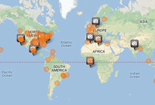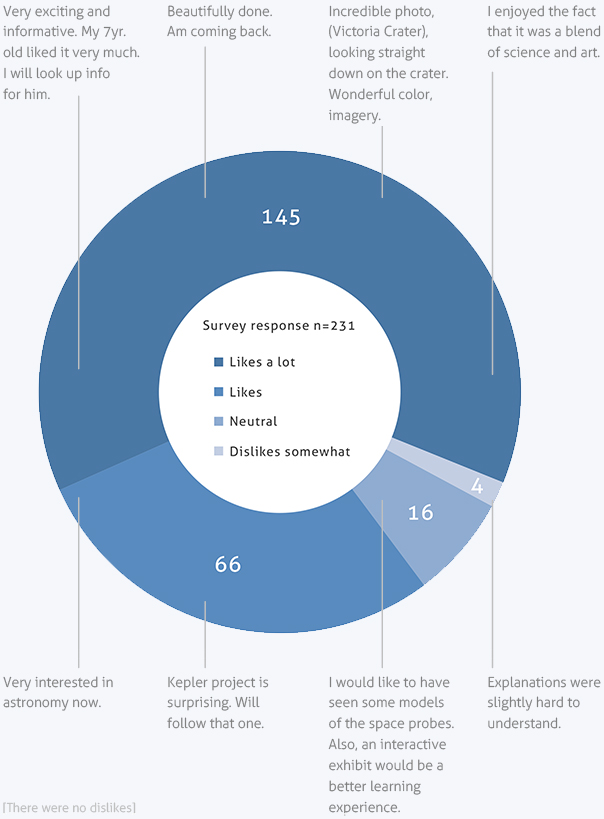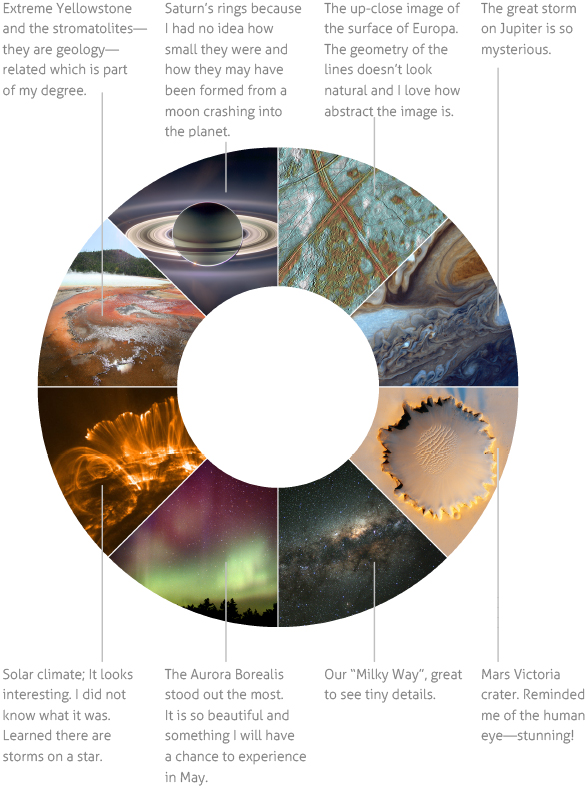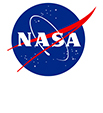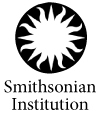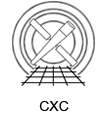
The From Earth to the Solar System (FETTSS) project exhibits images from across the Solar System in public venues such as parks, libraries and other free, community-based public science locations to provide multi-generational and family-friendly content in English and Spanish. The purpose of the program is to communicate crosscutting NASA content (in heliophysics, planetary science and multiwavelength astrophysics) with casual and/or non-intentional audiences—members of the public who may not already be heavily invested in science. The program utilizes an online repository built at no-cost that encourages replication of exhibits suitable for local adaptation around the world, as well as a NASA-funded traveling exhibit visiting over a dozen US locations from 2011-2012.
From Earth to the Solar System (FETTSS) was conceived as a direct response for NASA's Year of the Solar System (which ran for one Martian year, from October 2010 through August 2012), and provides a solid case study for the category of public science events.
As with its predecessor project, From Earth to the Universe (FETTU), the FETTSS organizational structure follows a grass-roots approach (Russo & Christensen, 2010) in which local organizers are provided with high-quality, accurate materials to print their own version of the exhibition for their selected venues. The FETTSS project supplies high-resolution electronic files that have been approved for non-commercial outreach use to be displayed in any way that makes sense for a given venue, with the printing, installation, and other logistics are the responsibility of the local hosts.
Such global-to-local methodologies in distributed curation offer exponential increases in exposure and impact from an original single-noded project, expanding access beyond the cost of the original EPOESS-funded US program into an international public science program.
The existing international FETTU network was leveraged to advertise the FETTSS opportunity beyond NASA and U.S.-specific audiences. As of March 2013, over 100 venues from around the world have hosted FETTSS events, from cafés in New Zealand to a mall in Texas.
View the published papers on FETTSS and public science results.
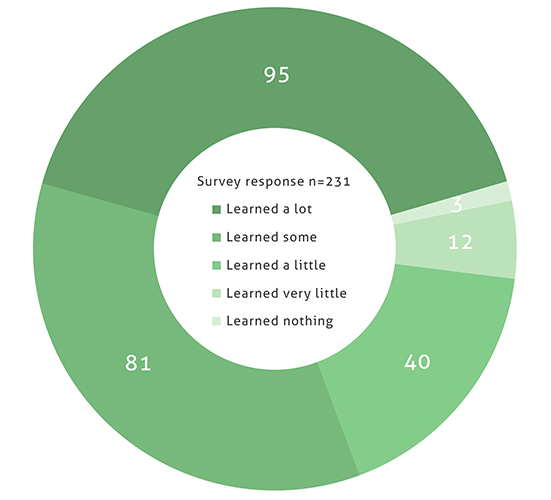
- Venus rotates opposite Earth's rotation.
- That not all stars go from a Red Giant to a Blue Giant.
- About the existence of water on other planets that although frozen this increased my thinking that life man exist not only on Earth.
- That the rings of Saturn resulted from a collision with a moon.
- About Uranus. I did not know it rotated sideways.
- The size of the spot on Jupiter is the size of the Earth.
- At first I didn't know the organisms that lived in Yellowstone. I feel like checking it out on the internet.
- I enjoyed learning about the various conditions on the planets. I found the Geminid meteor mystery really interesting.
- Study of lakes helps scientists to learn more about climate change's impact on environment.
- How we study place on Earth to learn more about space (Andes Mts.)
- Europa – the distinct lines and massive tides are interesting.
| Sites | Reference | Locale | No. of Surveys | Males | Females | Average Age |
| Corpus Christi U. Texas* | CC | Shopping Mall | 50 | 25 | 25 | 34 |
| National Air and Space Museum | NASM | Outside | 52 | 29 | 23 | 42 |
| Central Florida U. | CFU | University Library | 33 | 18 | 15 | 28 |
| Union Station Kansas City | KC | Outside the Planetarium | 14 | 7 | 7 | 33 |
| Penn State, PA* | PS | Off-Campus Art Gallery | 48 | 20 | 28 | 47 |
| University of Puerto Rico* | PR | Community Library | 49 | 28 | 21 | 25 |
| Total | 246 | 127 | 119 | 35 |
| Sites | Some HS | HS Grad | Some College | College Grad. | Some grad. school | Masters | Prof. Degree |
| CC | 10 | 18 | 32 | 14 | 14 | 8 | 4 |
| NASM | 6 | 8 | 27 | 17 | 12 | 19 | 12 |
| CFU | 3 | 3 | 48 | 15 | 12 | 6 | 12 |
| KC | 0 | 14 | 36 | 21 | 7 | 14 | 7 |
| PS | 0 | 4 | 6 | 31 | 8 | 25 | 25 |
| PR | 6 | 14 | 51 | 14 | 0 | 8 | 6 |
| Overall, how do you feel about From Earth to the Solar System? |
|
| Disliked/Liked | 4.6 |
| Learned Nothing/Learned a lot | 4.2 |
| Boring/Fascinating | 4.2 |
| To what extent has seeing From Earth to the Solar System increased or decreased your interest in the following? | |
| Astronomy | 3.9 |
| Attending another science event | 3.9 |
| Reading about science on-line | 3.8 |
| Which particular image or images stand(s) out in your mind? Please Explain. | |
| Science | Art |
| Milky Way. Within the huge Milky Way, Earth is there. | "Space Weather"—Awesome to see such solar detail. Our "Milky Way", great to see tiny details. |
| Our moon is a tool of study | The sun's weather—a vision of the sun unlike anything I've ever seen or thought of before. |
| Iapetus. I want to know exactly how it got so dirty. | Infrared and planet surfaces are awesome |
| The sunspots because I am fascinated by them! Extreme Yellowstone and the stromatolites—they are geology—related which is part of my degree. | Milky Way images are awe-inspiring. Laguna Verde—beautiful to see pictures of earth with analogs in space. |
| The Andes volcanic lakes—would be cool to be a scientist there. Wonder how they got up there. | The Aurora Borealis stood out the most. It is so beautiful and something I will have a chance to experience in May. |
| Saturn's rings because I had no idea how small they were and how they may have been formed from a moon crashing into the planet. | Mars Victoria crater. Reminded me of the human eye—stunning! |
| Frozen Moon because of the ice. There could possibly be ice. | The great storm on Jupiter is so mysterious. |
| Solar climate; It looks interesting. I did not know what it was. Learned there are storms on a star. | The up-close image of the surface of Europa. The geometry of the lines doesn't look natural and I love how abstract the image is. |
| The image of Europa. I did not know ice existed on other parts of the solar system. | Centaurus A. It looks like a painting done by hand. It is beautiful. |
| What is something you have learned or learned more about from FETTSS? Factual Responses | |
| Venus rotates opposite Earth's rotation. | |
| I learned that Huygens had returned surface photos of Titan | |
| Stromatolites! | |
| Titan's surface (very cool!) | |
| That not all stars go from a Red Giant to a Blue Giant | |
| About the existence of water on other planets that although frozen this increased my thinking that life man exist not only on Earth. | |
| That the rings of Saturn resulted from a collision with a moon. | |
| About Uranus. I did not know it rotated sideways. | |
| The size of the spot on Jupiter is the size of the Earth. | |
| At first I didn't know the organisms that lived in Yellowstone. I feel like checking it out on the internet. | |
| I enjoyed learning about the various conditions on the planets. I found the Geminid meteor mystery really interesting. | |
| Study of lakes helps scientists to learn more about climate change's impact on environment. | |
| How we study place on Earth to learn more about space (Andes Mts.) | |
| Europa—the distinct lines and massive tides are interesting. | |
| There might be life on moons – arsenic based life is possible. | |
| General comments compiled across sites in actual numbers | |
| Positive | 76 |
| Negative | 4 |
| Suggestions | 7 |
| Total | 87 |
| General Comments Across Sites | ||
| Positive | Negative | Suggestions |
| Very exciting and informative. My 7yr. old liked it very much. I will look up info for him. | While interesting, I would prefer more artistic exhibits (vs. science) in this space. (from PS) | Bring more photos, more variety. |
| Beautifully done. Am coming back. | The pictures are cool but the labels are not very stimulating or interesting, | Would like to see relative size of moons next to each planet they circle. |
| Incredible photo, (Victoria Crater), looking straight down on the crater. Wonderful color, imagery. | Interesting, but I am not sure I retained a large proportion of all the info I read. | I would like to have seen some models of the space probes. Also, an interactive exhibit would be a better learning experience. |
| Very interested in astronomy now. | Explanations were slightly hard to understand. | Wish there was more than just pictures. Go Science! |
| Kepler project is surprising. Will follow that one. | It would be great to have a scale of some sort with the images to show where you are out from the sun. | |
| Eye-catching! | ||
| I am an astronomy graduate student so most of the information is review but still great to see alongside beautiful images. | ||
| I enjoyed the fact that it was a blend of science and art. | ||
